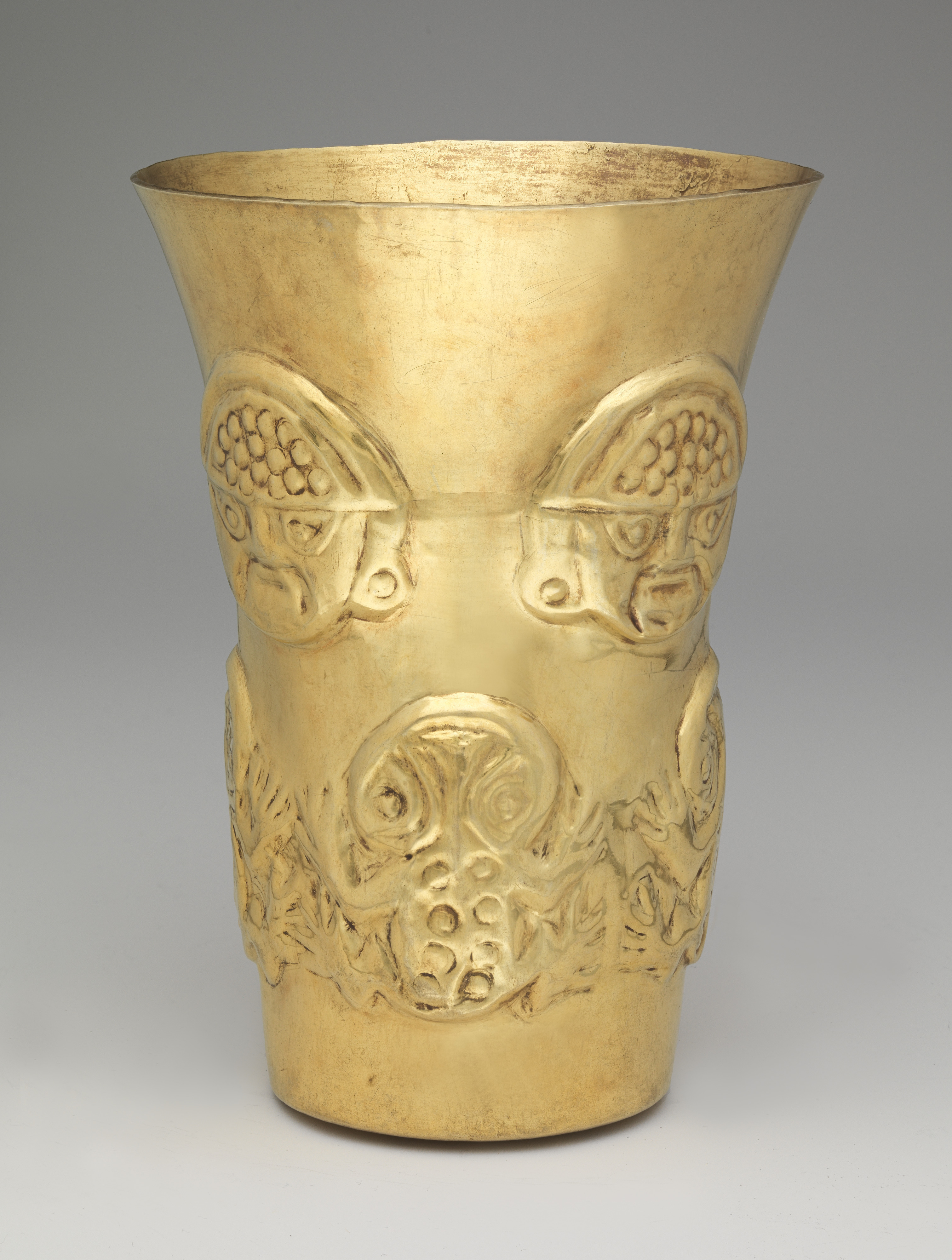Beaker with heads and toads
This flared beaker likely once held ritual liquids, possibly chicha, a fermented corn beverage imbibed widely throughout what is now South America. Created by artists of the Lambayeque (also known as Sicán) culture, the vessel was fashioned from a blank or ingot that was first hammered into a thin sheet then shaped over a wooden mold. Such standardization allowed the Lambayeque to develop a large-scale industry around metalworking on the northern Pacific coast of Peru, so much so that a single high-status tomb could feature hundreds of metal objects.
Amphibians like frogs and toads are recurrent subjects in Lambayeque art, as demonstrated by the beaker seen here, which features four such animals rendered in repoussé, their legs and feet splayed as if gripping the sides of the beaker. The body of each amphibian is marked with two rows of circles, suggesting that these particular examples are bufo or cane toads, which are native to South America and have raised spotted membranes. These animals typically appear before rainfall, a life-sustaining necessity on the desert coast of Peru, and are therefore associated with fertility and propitious harvests. Cane toads are also poisonous, with enlarged parotoid glands—depicted on this beaker as curved lines around the amphibians’ eyes—that secrete a toxin sometimes used as an entheogen. Above these toads, on the upper register of the beaker, are four disembodied heads or possibly funerary masks (see 1974.271.35), each crowned with a crescent-shaped headdress that features a cluster of circles likely representing turquoise inlays or round metal danglers, common ornamental elements seen on Lambayeque headwear. These circles, in light of the amphibian motifs, may also allude to toad or frog eggs, further emphasizing notions of fecundity and abundance.
Ji Mary Seo, Andrew W. Mellon Fellow, The Michael C. Rockefeller Wing, 2023-2024
References
Carcedo Muro de Mufarech, Paloma. “Los vasos en la orfebrería sicán.” In Cultura Sicán: Esplendor preincaico de la costa norte, edited by Izumi Shimada, 107-146. Lima: Fondo Editorial del Congreso del Perú, 2014.
Carcedo Muro de Mufarech, Paloma, and Izumi Shimada. “Behind the Golden Mask: Sicán Gold Artifacts from Batán Grande, Peru.” In The Art of Precolumbian Gold: The Jan Mitchell Collection, edited by Julie Jones, 60-75. New York: The Metropolitan Museum of Art, 1985.
Shimada, Izumi. “El proyecto arqueológico de Sicán: Una caracterización.” In Cultura Sicán: Dios, riqueza y poder en la Costa Norte del Peru, edited by Izumi Shimada, 17-36. Lima: Fundación del Banco Continental para el Fomento de la Educación y la Cultura, 1995.
Vetter Parodi, Luisa, and Paloma Carcedo Muro de Mufarech. “The Use and Meaning of Gold in Ancient Peru.” In Reverse Engineering of Ancient Metals, edited by Patricia Silvana Carrizo, 41-79. Cham: Springer Nature Switzerland AG, 2021.
This image cannot be enlarged, viewed at full screen, or downloaded.
This artwork is meant to be viewed from right to left. Scroll left to view more.



